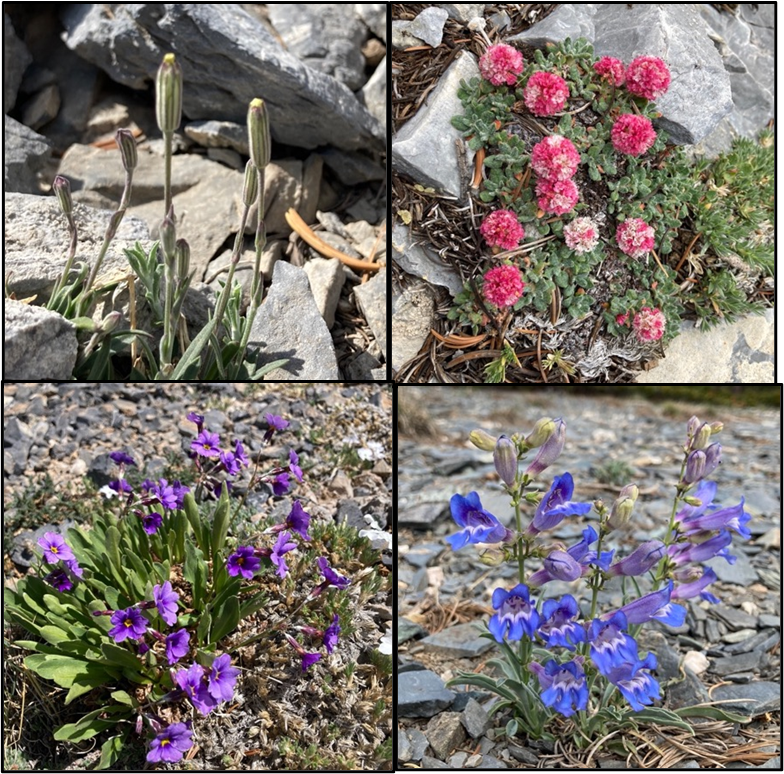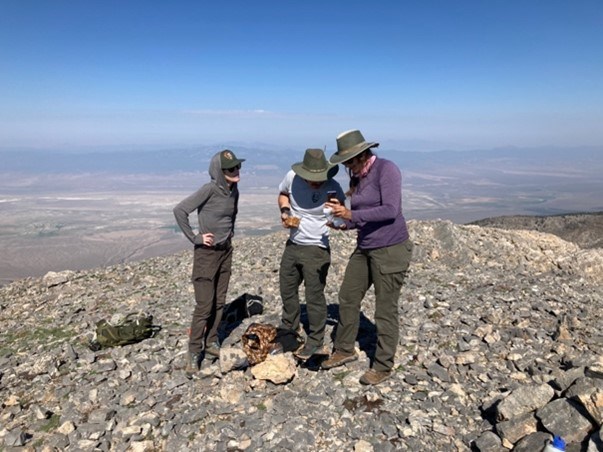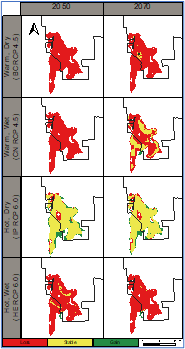Part of a series of articles titled The Midden - Great Basin National Park: Vol. 22, No. 2, Winter 2022.
Article
Life at the Top: Range Shifts of Four High Elevation Plants

Wade Plafcan
By Wade Plafcan and Thomas Albright, Researchers, University of Nevada, Reno
Starting in fall of 2021, Great Basin National Park, the University of Nevada, Reno, and botanist Jan Nachlinger began a project to track changes in recent and future distributions of four rare alpine plant species.
Nachlinger catchfly (Silene nachlingerae), Holmgren’s buckwheat (Eriogonum holmgrenii), Nevada primrose (Primula cusickiana var. nevadensis), and Pennell beardtongue (Penstemon leiophyllus var. francisci-pennellii) (Figure 1) are all rare, herbaceous plant species of conservation concern. They occur in high elevation habitats and are endemics, meaning they are limited to Great Basin National Park or a few other ranges in eastern Nevada. Being limited to the highest elevations means that there is no room for them to move higher to escape increasing temperatures and having a limited endemic distribution means they don’t have ‘backup’ locations. This combination makes these species especially vulnerable to anthropogenic driven climate change.
To investigate these changes we mapped the recent, current, and predicted future distributions of these plants using two surveys separated by 15 years. Our primary objective was to detect changes in plant distribution and elevation a) between two surveys conducted in 2004-2006 and 2021, and b) between current and projected mid-21st century climates. Additionally, we wanted to determine which environmental factors are most associated with plant habitat and identify locations important for conservation.

Wade Plafcan
Research indicates many alpine species are moving up in elevation to track more suitable (often cooler) habitat conditions. Unfortunately, for species already occurring on the tops of mountains, they may ‘run out of real estate.’ For example, the new populations of Holmgren’s buckwheat occurred at a mean elevation of 11,150 ft compared to 10,500 ft mean elevation of the individuals lost since the previous survey. A vertical difference as tall as the Space Needle!

NPS
To understand what might happen in the future, SDMs were projected into years 2050 and 2070. Multiple climate projections were used to hedge our bets on the uncertainty of future conditions. These projections included combinations of different amounts of greenhouse gas emissions, warming and both increasing and decreasing precipitation.
Results varied by species and by climate projection. Nachlinger catchfly is of most conservation concern, showing a potential loss of almost all favorable habitat by 2050. Pennell beardtongue may also lose a moderate amount of habitat and has the largest predicted increase in mean elevation, which could lead to habitat fragmentation over time. Holmgren’s buckwheat and Nevada primrose are predicted to be relatively stable and may even expand their habitat under some climate projections. However, contrary to the future models, the survey comparison results show these species may be experiencing upward range shifts already. Only time will reveal which method and analysis is more accurate.
Continued monitoring of these species will be important to track changes and verify model predictions. Monitoring climate change-altered precipitation levels will be of paramount importance, as the driest climate projection predicts substantial habitat loss for all species. Snow, precipitation, and temperature are very important variables for the biology and phenology of these species. Fortunately, the SNOTEL (Snowpack Telemetry) weather station, established in 2011 near Wheeler Peak, will provide great data on changes associated with these climate variables.
Our finding that range shifts from a warming climate may already be occurring is a bit jarring but not unexpected. Our hope for the future is that we can avoid the worst of climate change by reducing emissions globally, and that conservation biologists can help to ensure that species and habitats are protected in the right places to be able to weather the climate changes that do come our way.
Last updated: February 5, 2024
